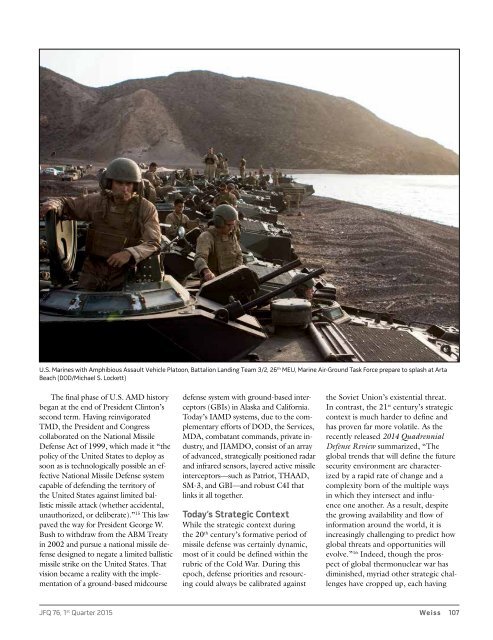jfq-76
jfq-76
jfq-76
Create successful ePaper yourself
Turn your PDF publications into a flip-book with our unique Google optimized e-Paper software.
U.S. Marines with Amphibious Assault Vehicle Platoon, Battalion Landing Team 3/2, 26 th MEU, Marine Air-Ground Task Force prepare to splash at Arta<br />
Beach (DOD/Michael S. Lockett)<br />
The final phase of U.S. AMD history<br />
began at the end of President Clinton’s<br />
second term. Having reinvigorated<br />
TMD, the President and Congress<br />
collaborated on the National Missile<br />
Defense Act of 1999, which made it “the<br />
policy of the United States to deploy as<br />
soon as is technologically possible an effective<br />
National Missile Defense system<br />
capable of defending the territory of<br />
the United States against limited ballistic<br />
missile attack (whether accidental,<br />
unauthorized, or deliberate).” 15 This law<br />
paved the way for President George W.<br />
Bush to withdraw from the ABM Treaty<br />
in 2002 and pursue a national missile defense<br />
designed to negate a limited ballistic<br />
missile strike on the United States. That<br />
vision became a reality with the implementation<br />
of a ground-based midcourse<br />
defense system with ground-based interceptors<br />
(GBIs) in Alaska and California.<br />
Today’s IAMD systems, due to the complementary<br />
efforts of DOD, the Services,<br />
MDA, combatant commands, private industry,<br />
and JIAMDO, consist of an array<br />
of advanced, strategically positioned radar<br />
and infrared sensors, layered active missile<br />
interceptors—such as Patriot, THAAD,<br />
SM-3, and GBI—and robust C4I that<br />
links it all together.<br />
Today’s Strategic Context<br />
While the strategic context during<br />
the 20 th century’s formative period of<br />
missile defense was certainly dynamic,<br />
most of it could be defined within the<br />
rubric of the Cold War. During this<br />
epoch, defense priorities and resourcing<br />
could always be calibrated against<br />
the Soviet Union’s existential threat.<br />
In contrast, the 21 st century’s strategic<br />
context is much harder to define and<br />
has proven far more volatile. As the<br />
recently released 2014 Quadrennial<br />
Defense Review summarized, “The<br />
global trends that will define the future<br />
security environment are characterized<br />
by a rapid rate of change and a<br />
complexity born of the multiple ways<br />
in which they intersect and influence<br />
one another. As a result, despite<br />
the growing availability and flow of<br />
information around the world, it is<br />
increasingly challenging to predict how<br />
global threats and opportunities will<br />
evolve.” 16 Indeed, though the prospect<br />
of global thermonuclear war has<br />
diminished, myriad other strategic challenges<br />
have cropped up, each having<br />
JFQ <strong>76</strong>, 1 st Quarter 2015 Weiss 107




